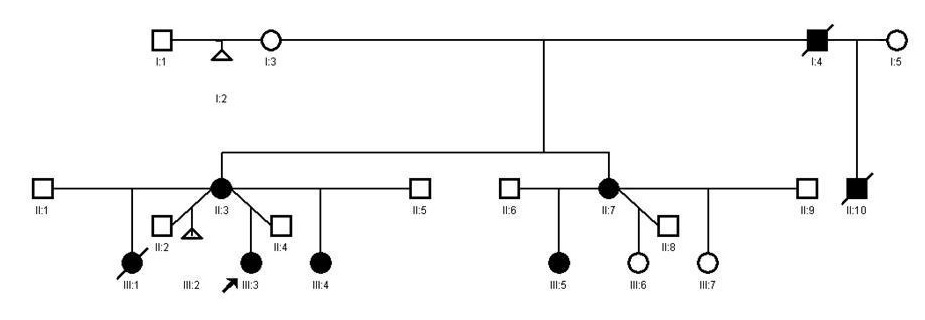Síndrome de Adams-Oliver y complicaciones asociadas: reporte de una familia en Colombia y revisión de la literatura
Resumen
El síndrome de Adams-Oliver es un trastorno congénito raro, caracterizado por aplasia cutis congénita en el cuero cabelludo, defectos terminales transversales de las extremidades y piel marmorata telangiectásica congénita. Este puede presentarse debido a diferentes patrones de herencia de tipo autosómico dominante o autosómico recesivo, o por mutaciones dominantes de novo.
Aunque el síndrome de Adams-Oliver es una enfermedad poco frecuente, es importante conocer sus características clínicas y patrones de herencia, para así establecer un correcto diagnóstico y sus posibles complicaciones durante el seguimiento. En el presente estudio, se describe el caso de una adolescente con síndrome de Adams-Oliver con patrón de herencia autosómica dominante, hipertensión pulmonar y bronquitis plástica. Había varios miembros de su familia con el mismo compromiso.
Descargas
Referencias bibliográficas
Piazza AJ, Blackston D, Sola A. A case of Adams-Oliver syndrome with associated brain and pulmonary involvement: Further evidence of vascular pathology? Am J Med Genet A. 2004;130A:172-5. https://doi.org/10.1002/ajmg.a.30210
Lehman A, Wuyts W, Patel MS. Adams-Oliver syndrome. In: Adam MP, Everman MB, Mirzaa GM, Pagon RA, Wallace SE, Bean L, et al, editors. Gene Reviews. Seattle (WA): University of Washington; 1993.
Schröder KC, Duman D, Tekin M, Schanze D, Sukalo M, Meester J, et al. Adams-Oliver syndrome caused by mutations of the EOGT gene. Am J Med Genet A. 2019;179:2246-51. https://doi.org/10.1002/ajmg.a.61313
Sukalo M, Tilsen F, Kayserili H, Müller D, Tüysüz B, Ruddy DM, et al. DOCK6 mutations are responsible for a distinct autosomal-recessive variant of Adams-Oliver syndrome associated with brain and eye anomalies. Hum Mutat. 2015;36:593-8. https://doi.org/10.1002/humu.22795
Southgate L, Sukalo M, Karountzos AS, Taylor EJ, Collinson CS, Ruddy D, et al. Haploinsufficiency of the NOTCH1 receptor as a cause of Adams-Oliver syndrome with variable cardiac anomalies. Circ Cardiovasc Genet. 2015;8:572-81. https://doi.org/10.1161/CIRCGENETICS.115.001086
Meester JA, Southgate L, Stittrich AB, Venselaar H, Beekmans SJ, den Hollander N, et al. Heterozygous loss-of-function mutations in DLL4 cause Adams-Oliver syndrome. Am J Hum Genet. 2015;97:475-82. https://doi.org/10.1016/j.ajhg.2015.07.015
Hassed SJ, Wiley GB, Wang S, Lee JY, Li S, Xu W, et al. RBPJ mutations identified in two families affected by Adams-Oliver syndrome. Am J Hum Genet. 2012;91:391-5. https://doi.org/10.1016/j.ajhg.2012.07.005
Shaheen R, Faqeih E, Sunker A, Morsy H, Al-Sheddi T, Shamseldin HE, et al. Recessive mutations in DOCK6, encoding the guanidine nucleotide exchange factor DOCK6, lead to abnormal actin cytoskeleton organization and Adams-Oliver syndrome. Am J Hum Genet. 2011;89:328-33. https://doi.org/10.1016/j.ajhg.2011.07.009
Shaheen R, Aglan M, Keppler-Noreuil K, Faqeih E, Ansari S, Horton K, et al. Mutations in EOGT confirm the genetic heterogeneity of autosomal-recessive Adams-Oliver syndrome. Am J Hum Genet. 2013;92:598-604. https://doi.org/10.1016/j.ajhg.2013.02.012
Meester JAN, Sukalo M, Schröder KC, Schanze D, Baynam G, Borck G, et al. Elucidating the genetic architecture of Adams-Oliver syndrome in a large European cohort. Hum Mutat. 2018;39:1246-61. https://doi.org/10.1002/humu.23567
Kojmane W, Hmami F, Atmani S. Syndrome d’Adams-Oliver et cutis marmorata telangiectatica congenita [Adams-Oliver syndrome and cutis marmorata telangiectatica congenita]. Ann Dermatol Venereol. 2019;146:223-5. https://doi.org/10.1016/j.annder.2018.11.009
Meyer BI, Williams PJ, Hanif AM, Lenhart PD, Hubbard GB 3rd, Jain N. Proliferative retinopathy in a 13-year-old with Adams-Oliver syndrome. Retin Cases Brief Rep. 2020. https://doi.org/10.1097/ICB.0000000000001073
Hassed S, Li S, Mulvihill J, Aston C, Palmer S. Adams-Oliver syndrome review of the literature: Refining the diagnostic phenotype. Am J Med Genet A. 2017;173:790-800. https://doi.org/10.1002/ajmg.a.37889
Dudoignon B, Huber C, Michot C, Di Rocco F, Girard M, Lyonnet S, et al. Expanding the phenotype in Adams-Oliver syndrome correlating with the genotype. Am J Med Genet A. 2020;182:29-37. https://doi.org/10.1002/ajmg.a.61364
Algaze C, Esplin ED, Lowenthal A, Hudgins L, Tacy TA, Selamet-Tierney ES. Expanding the phenotype of cardiovascular malformations in Adams-Oliver syndrome. Am J Med Genet A. 2013;161A:1386-9. https://doi.org/10.1002/ajmg.a.35864
O’Neill M. Adams-Oliver Syndrome 5; AOS5. Adams-Oliver syndrome 5; AOS5. Fecha de consulta: 28 de julio del 2022. Disponible en: https://www.omim.org/entry/616028?search=SINDROME%20DE%20ADAMS%20OLIVER&highlight=adam%20de%20oliver%20sindrome
Hoyme HE, Jones KL, van Allen MI, Saunders BS, Benirschke K. Vascular pathogenesis of transverse limb reduction defects. J Pediatr. 1982;101:839-43. https://doi.org/10.1016/s0022-3476(82)80343-0
Toriello HV, Graff RG, Florentine MF, Lacina S, Moore WD. Scalp and limb defects with cutis marmorata telangiectatica congenita: Adams-Oliver syndrome? Am J Med Genet. 1988;29:269-76. https://doi.org/10.1002/ajmg.1320290204
Chitayat D, Meunier C, Hodgkinson KA, Robb L, Azouz M. Acrania: A manifestation of the Adams-Oliver syndrome. Am J Med Genet. 1992;44:562-6. https://doi.org/10.1002/ajmg.1320440506
Fryns JP, Legius E, Demaerel P, van den Berghe H. Congenital scalp defect, distal limb reduction anomalies, right spastic hemiplegia and hypoplasia of the left arteria cerebri media. Further evidence that interruption of early embryonic blood supply may result in Adams-Oliver (plus) syndrome. Clin Genet. 1996;50:505-9. https://doi.org/10.1111/j.1399-0004.1996.tb02723.x
Swartz EN, Sanatani S, Sandor GG, Schreiber RA. Vascular abnormalities in Adams-Oliver syndrome: Cause or effect? Am J Med Genet. 1999;82:49-52. https://doi.org/10.1002/(sici)1096-8628(19990101)82:1<49:aid-ajmg10>3.0.co;2-m
Patel MS, Taylor GP, Bharya S, Al-Sanna’a N, Adatia I, Chitayat D, et al. Abnormal pericyte recruitment as a cause for pulmonary hypertension in Adams-Oliver syndrome. Am J Med Genet A. 2004;129A:294-9. https://doi.org/10.1002/ajmg.a.30221
Mendoza-Soto A, Galletti L, Gómez de Quero P, Ramos-Casado MV, Velasco-Bayón JM. Bronquitis plástica. A propósito de un caso y revisión de los casos asociados a cirugía de Fontan. An Pediatr (Barc). 2005;62:72-5. https://doi.org/10.1157/13070185
Saeidi M, Ehsanipoor F. A case of Adams-Oliver syndrome. Adv Biomed Res. 2017;6:167. https://doi.org/10.4103/2277-9175.221861
Kasinathan A, Sharawat IK, Das G, Sankhyan N. Adams-Oliver syndrome: Limited expression. Indian J Pediatr. 2019;86:101-2. https://doi.org/10.1007/s12098-018-2720-2
Algunos artículos similares:
- Jorge Hernán Montoya, Olga Lucía Morales, Reporte de cuatro casos de pacientes con síndrome de Jarcho-Levin en el departamento de Antioquia, Colombia , Biomédica: Vol. 29 Núm. 1 (2009)
- Harry Pachajoa, Arelis Barragán, Javier Torres, Carolina Isaza, Pentalogía de Cantrell: reporte de un caso de padres consanguíneos , Biomédica: Vol. 30 Núm. 4 (2010)

Derechos de autor 2022 Biomédica

Esta obra está bajo una licencia internacional Creative Commons Atribución 4.0.
| Estadísticas de artículo | |
|---|---|
| Vistas de resúmenes | |
| Vistas de PDF | |
| Descargas de PDF | |
| Vistas de HTML | |
| Otras vistas | |

























